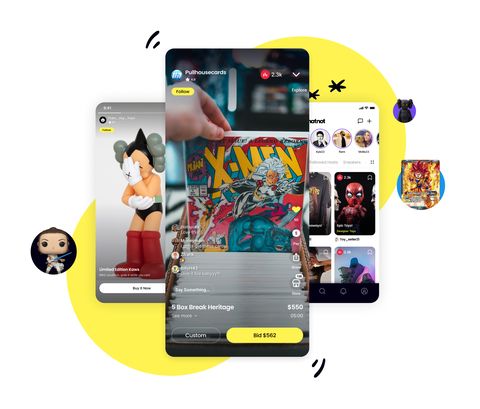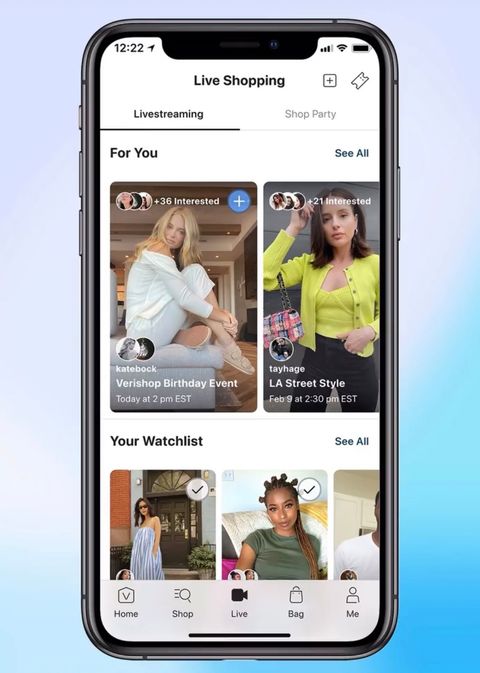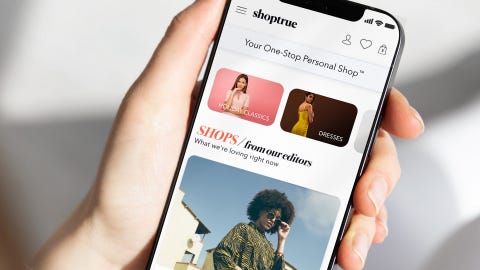Products You May Like
Nearly a year ago, Zoreen Kabani was consumed by an overwhelming sense of ennui. She felt stagnant, and, quite frankly, bored at the job she’d had for the last nine years. So, the 35-year-old financial advisor switched to another company—and then promptly quit two weeks later. It wasn’t where she worked, she realized, but what she did.
It wasn’t until her brother introduced her to Whatnot, a livestreaming shopping platform-cum-online marketplace that co-founder Grant LaFontaine describes as “eBay meets Twitch,” that she found her calling. For the first few months, Kabani was a spectator, tuning into livestreams and getting to know the streamers, before going live for the first time in June. In the months that followed, Kabani had sold an estimated 6,000 products, garnered a following of nearly 10,000, and made $12,000 in her first month alone, and, remarkably, $50,000 in the first three.
“I fell in love with it right away, and now, Whatnot is my life,” says the Dallas-Fort Worth-based streamer, who adheres to a rigorous Monday to Friday schedule, going live at 10 P.M. ET to an audience ranging from 85 to 200 people and selling clothing that she sources from anywhere, from online sales to thrift stores and other people’s closets. “I treat this like my corporate job. I shop constantly—and that’s been my thing: dressing up and looking cute. It’s something my clients look for, to see what I’m wearing.”
Her story—one of success at livestreaming as a one-woman show and making a living from it—serves as a testament to what many are predicting will become the next frontier of e-commerce: the live shopping era. Already, we’ve seen the live function across social media, namely Instagram, YouTube, and TikTok. But as livestreams exist right now, from a shopping angle, they’re all over the place. No one has definitively cracked the code, so to speak. That means they all exude different vibes, formats, and formulas, depending on the streamer, the inventory, and the platform.
Amazon recently relaunched its livestream platform (the tech giant’s first attempt in 2016 was met with little fanfare), ramping up the feature by partnering with its influencer program (including the likes of Lala Kent and JoJo Fletcher) to ensure success. YouTube hosted “YouTube to You,” a week-long holiday event featuring shoppable shorts and long-form videos with 30-plus content creators and brands—one of which included a joint partnership between Ulta Beauty, Tula Skincare, and YouTubers Manny MUA, Amber Scholl, Mai Pham, and AllyiahsFace for a highly produced livestream (complete with a stage, a director, and teleprompters) that felt like QVC-meets-HSN for the digital age. On Whatnot, some streams are reminiscent of auctions (super chaotic, super high-energy, with bids, giveaways, and all). And on Verishop, an online retailer that boasts a roster of 4,000-plus independent brands, others are incredibly low-key and no frills—a streamer simply talking to the camera.
“Livestream shopping has been a hit internationally for some time now, but it has begun to make an impact in the U.S. market during Covid as our palate for video content evolved,” says Kendall Becker, fashion and beauty trends editor at retail analytics platform Trendalytics. “Searches for livestream shopping are marked as ‘low’ within our platform. While it’s such a new trend, we certainly see this before the consumer starts solidifying exactly how to search and interact with new content forms. Social media posts regarding ‘livestream shopping’ have begun to ebb and flow over the past few months, spiking up to +700 percent compared to the amount of posts on the topic last year.”
Indeed, livestream shopping has historically been more of a phenomenon internationally, especially in APAC—or more specifically, China. It can be traced to May 2016 when Chinese retail giant Alibaba launched Taobao, linking a livestream broadcast with e-commerce for the first time, ushering in “a new chapter in sales.” And the numbers are astounding: The first 30 minutes of Alibaba’s 2020 Singles’ Day shopping event on Taobao raked in $7.5 billion in sales, according to McKinsey. Which begs the question: will the U.S. follow in China’s footsteps?
“Live shopping in China has this huge celebrity and influencer ecosystem behind it, so while I do expect the landscape in the U.S. to follow a similar path, we’re in the early days of consumer adoption and awareness—and these things take longer than people think,” says LaFontaine, who initially launched Whatnot to provide hobbyists and collectors of Funko Pops, sports cards, and comic books a meeting ground to gather, sell, and buy. But Whatnot has since expanded to 80 categories, with fashion as the fastest growing segment. “Nothing’s ever one-to-one, but I don’t think it’s crazy to say that in five to 10 years, 40 or 50 percent of e-commerce sales will occur through video. It’ll look different, because it’s certainly starting in a different place.”
It’s worthwhile to note that livestream shopping in China only accounts for roughly 10 percent of the country’s gross merchandise value, though it’s expected to increase to 24.3 percent in 2023 (still a relatively small percentage). If we were to think about how that would translate to the e-commerce infrastructure in the U.S., Imran Khan, co-founder and CEO of Verishop, believes live shopping won’t necessarily replace any one particular way we purchase items, but will instead serve as a supplement to how we approach shopping. “Live shopping will become part of an overall e-commerce experience. When a livestream ends, we take it, cut it into mini clips, and put them on product pages—we see an almost 40 percent improvement in conversion, meaning that a product with a video review will have a 40 percent higher conversion rate compared to a product without a video,” say Khan, noting that, as of now, only a small percentage of products have a video (though that number is marginally higher in the beauty category). “I think livestream is going to be an important part of storytelling; if you can create a video library, reduce your return rate, and improve your conversion rate, that’s huge.”
What livestream ultimately solves is most of the pain points that come hand in hand with e-commerce. In real life, there’s not only the joy of discovery, but there’s also the tactile experience of knowing exactly what you’re purchasing.
“We’ve all been in that trap where you click on a pair of black pants, and then all you see are black pants,” says Brandon Holley, former editor-in-chief of Lucky and chief fashion officer at Shoptrue, a marketplace with 2,000-plus brands that combines AI with human expertise in the hopes that instead of regurgitating previously purchased products, it suggests recommendations in much the same way that a glossy magazine would. In other words, to provide the discovery that’s lacking in the e-commerce landscape. “I really believe e-commerce has a listening problem. And I think livestream is a huge opportunity because that discovery is live—and you have that immediate reaction. It’s an exciting place for e-commerce to embrace a little more.” (As of now, Shoptrue is in beta mode, and its plans to launch livestream are currently in the pipeline.)
One singular shopping memory sticks out to her: Holley once walked into a store and the salesperson sold her on a $4,000 green coat that she never would have purchased otherwise. “I was convinced it was going to change my life—I wore it so much. I loved that green coat,” she remembers. “That discovery—that’s what’s missing from e-commerce.”
Of course, a video (livestream or otherwise) can’t entirely replace the touch and feel of an actual garment, but it can come pretty damn close—by proxy, that is. And Scholl, a 29-year-old L.A.-based YouTuber, hopes to be that person for her 3.6 million subscribers, who trust her for recommendations. (In fact, Bridget Dolan, managing director of shopping partnerships at YouTube, says YouTube is the most trusted platform for its creators.) Even though Scholl hasn’t launched regularly scheduled livestream programming on her channel just yet, she already knows hers would be “something I would want to watch as a consumer. If it’s a necklace, I’d want to see the stone up close, if the chain is adjustable, what kind of clasp it is, what kind of material it is, what the vibe is like,” she says. “That gives me a distinct advantage as an extreme shopper—I know what people want to know. The biggest appeal is seeing products in real time—it’s more real than a photo on a website.”
She’s right: Livestreams provide viewers with direct access to streamers (and by extension, the product itself) through real-time interactions. And because of that, it fosters kinship, trust, and, on a grander scale, community. For Kabani, streaming is less about selling, and more about establishing connections. In the few months she’s been going live at Whatnot, she’s formed friendships with both other sellers and her customers.
“I always joke that I’m a loner, but when I’m on Whatnot, it doesn’t feel like I’m working. It feels more like a hangout with my besties than anything else,” says Kabani, who’s constantly brainstorming creative ways to keep her followers hooked, whether that’s through raffles, themed streams, giveaways, or collaborations. “And I think people become invested in you as a seller, so my people, they support me and my dreams.”
She likens livestreaming to reality TV in that it’s another form of entertainment. Because, unlike Instagram or even TikTok, the greatest, undeniably delightful draw of tuning into a livestream is its raw, unedited, unfiltered, off-the-cuff spirit. That in and of itself is why so many believe the medium will continue to gain momentum.
“It’s why we watch SNL—it’s high stakes. Anything could go wrong at any moment. And it’s a chance for experts to really do their thing, because you can see them react in real time. You can’t fake it, and if you’re good at what you do, that’s really compelling entertainment,” Holley muses. “But I think livestream honestly suffers from the same thing as e-commerce, which is that it’s very pushy—I call it ‘stroking the boot.’ If we can get out of this nascent stage, this QVC formula, and make it more personal and interactive, it has the potential to become really exciting.”
There’s no doubt that the rise of live shopping will give content creators considerable power, solely based on their ability to move products. But Khan warns that it’s a double-edged sword: “Yes, it will give content creators more influence to drive transactions, but it will also create more transparency, because you can measure it immediately through sales and numbers. It’s different from pushing a brand experience, which is very opaque.”
Scholl finds that particular aspect utterly fascinating, knowing exactly when her followers bought a product or when they’ve dropped off—all predicated on something she’s said. “If you’re passionate about shopping like I am—I can talk about shopping for hours—and you love it, you can convince others to love it, too,” she says. “If you love watching live shopping, it’ll never get old. People will keep tuning in.”
LaFontaine echoes that sentiment. Shopping has always been a pastime, and it will continue to be. “When I was a kid, I used to hang out at the mall and buy stuff, so with livestream, people will probably be spending even more time shopping,” he says. “It’s human behavior to have fun, to shop, to be entertained—those desires aren’t going to go away. There’s no question that livestream can change the way people shop.”

Andrea Cheng is a New York-based writer who writes about fashion and beauty. Her work has been featured in the New York Times, Glamour, Allure, Fashionista and more. Follow her on Twitter and Instagram @andrealeecheng.



